Home » Gemstones » Strontium Titanate
Strontium Titanate
A man-made diamond simulant also known as Fabulite, Diagem, Marvelite, Jewelite, and other trade names.
Author: Hobart M. King, PhD, GIA Graduate Gemologist
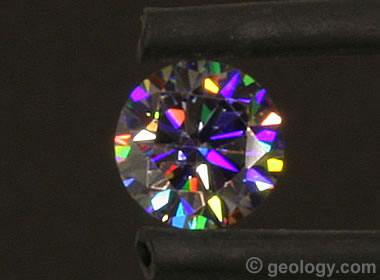
Strontium Titanate: A faceted strontium titanate showing its very strong "fire" or "dispersion." Light that enters the stone is separated into its component colors, similar to a prism, and exits the stone in a scintillation of color. This stone is a 6-millimeter round weighing about 1.25 carats. The stone has a slightly purple body color that provides contrast to the dispersion.
What is Strontium Titanate?
Strontium Titanate is a man-made material with a chemical composition of SrTiO3. It grabbed public attention in the early 1950s as a diamond simulant - a material that has an appearance that is very much like diamond but has a different composition and/or crystal structure.
When cut and polished like a diamond, strontium titanate has a very similar luster, brilliance, and scintillation. However, strontium titanate has a "fire" that greatly exceeds the fire of a diamond. "Fire" is the ability of a gem to act as a prism and separate light passing through it into a rainbow of colors. The fire of strontium titanate is so strong that it immediately surprises the observer.
Table of Contents
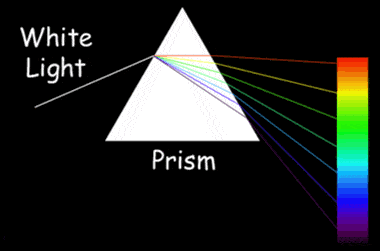
A demonstration of dispersion: White light is separated into its component colors while passing through a prism. The "fire" of faceted stones like diamond and strontium titanate is produced by dispersion. NASA Image.
The Rise and Decline of Strontium Titanate
The impressive fire of strontium titanate made the stone a rapid success in the jewelry trade. People loved the intense fire and the lower price compared to diamond, and many purchased strontium titanate instead of diamond. Many people bought it just because they loved its appearance.
Savvy merchants invented exotic trade names for strontium titanate such as "Fabulite," "Diagem," "Marvelite," "Dynagem," and "Jewelite." The name "strontium titanate" was hard to remember and resembled the name of a "chemical." The trade names inspired a vision of beautiful stones and were easy for consumers to remember.
Between the early 1950s and the early 1970s, Fabulite, Diagem, and the other strontium titanate brands were popular sellers. Then, many people who purchased strontium titanate jewelry and wore it regularly began to notice that their stones were showing signs of wear. The facet faces were often scratched, and facet edges were often nicked and chipped. A material with a Mohs hardness of 5.5 does not stand up to wear like diamond with a hardness of 10, or ruby and sapphire with a hardness of 9.
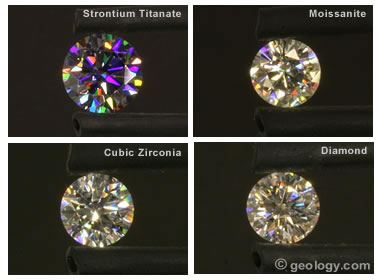
Strontium titanate dispersion: The photos above show how strontium titanate has a spectacular dispersion when compared to moissanite, CZ, and diamond. Its dispersion is a little less than double that of moissanite, triple that of CZ, and more than quadruple that of diamond. In the photo above, the strontium titanate is a 6-millimeter round. The other stones are 4-millimeter rounds. This difference in size does give strontium titanate an advantage.
Comparison of Diamond and Diamond Simulants |
||||
Material |
Refractive Index |
Dispersion |
Hardness |
Popular During |
| Diamond | 2.417 |
0.044 |
10 |
1500s to present |
| Strontium Titanate | 2.41 |
0.190 |
5.5 |
1950s to 1970s |
| YAG | 1.83 |
0.028 |
8.3 |
1970s |
| GGG | 1.97 |
0.045 |
7 |
1970s |
| CZ | 2.2 |
0.06 |
8.3 |
1970s to present |
| Moissanite | 2.66 |
0.104 |
8.5 - 9 |
1990s to present |
Competition From Other Diamond Simulants
Strontium titanate does not have the hardness and toughness of diamond, and that was a problem. It has a hardness of 5.5 -- low enough that contact with many common objects could result in a scratch or a damaged facet edge. This deficiency allowed newly developed simulants a place in the market.
Starting in the 1970s, simulants such as YAG (yttrium aluminium garnet), GGG (gadolinium gallium garnet) and cubic zirconia (CZ) quickly took market share away from strontium titanate. In the eye of many consumers, these simulants had an appearance that was similar to diamond and a durability that was superior to strontium titanate.
In the 1990s, synthetic moissanite began to replace YAG, GGG, and CZ in many of their uses. Its appearance is very similar to diamond, but it has a hardness and fire that is superior to all of these simulants from the 1970s. Cubic zirconia remains an important diamond simulant because its price is much lower than synthetic moissanite.
Today, strontium titanate is seldom seen in jewelry; however, it still has a more impressive fire than any natural or lab-created gemstone that is frequently seen in jewelry. It remains an attractive and satisfactory stone for earrings, pendants, and brooches that will encounter little abrasion or impact.
Differentiating Strontium Titanate from Diamond
Strontium titanate can be differentiated from diamond using a number of properties. On a quick visual inspection, an experienced person will see that the dispersion of strontium titanate instantly stands apart from diamond, YAG, GGG, CZ, and moissanite. Strontium titanate sometimes contains bubbles that reveal its lab-created origin, and this distinguishes it from diamond. The much lower hardness of strontium titanate is usually obvious in jewelry that has been worn frequently. These stones will often exhibit levels of abrasion that are rarely seen in diamond, YAG, CZ, and moissanite.
Physical Properties: Strontium Titanate / Tausonite |
||
| Strontium Titanate (man-made) | Tausonite (natural) |
|
| Chemical Classification | Oxide | Oxide |
| Color | Usually colorless. Rare earth or transition metals can be added to produce red, orange, yellow, brown, blue. | Red, brown, orange, gray. |
| Streak | Colorless | Colorless |
| Luster | Adamantine | Adamantine |
| Diaphaneity | Transparent to translucent | Translucent to opaque |
| Cleavage | None | None |
| Mohs Hardness | 5.5 | 6 to 6.5 |
| Specific Gravity | 4.88 | 5.13 |
| Diagnostic Properties | Spectacular dispersion, attacked by HF | Spectacular dispersion, attacked by HF |
| Chemical Formula | SrTiO3 | SrTiO3 |
| Crystal System | Isometric | Isometric |
| Uses | Diamond simulant, optical instruments, voltage-dependent resistors, high-voltage capacitors, specialized ceramics, substrates for superconductors | None |
Tausonite - The Strontium Titanate Mineral
Naturally occurring strontium titanate was not known as a mineral until its discovery in 1982. It was first found in Eastern Siberia, Russia, and later occurrences were found in Paraguay and Japan. It is a very rare mineral, found in tiny cubic crystals, crystal clusters, and irregular masses. Natural specimens are typically so small and so rare that they have no commercial use beyond mineral specimens.
Use of Strontium Titanate
Strontium titanate was a very popular diamond simulant in the 1950s through the 1970s and was sold under a variety of trade names. Although its surprising fire captured the attention of consumers, its lack of durability resulted in consumer disappointment. It was replaced by materials such as YAG and cubic zirconia that are superior in hardness but inferior in dispersion.
Strontium titanate was originally manufactured by the National Lead Company (currently NL Industries), a company that produces a wide variety of lead, titanium, and strontium products for high-tech industries. In addition to its use as an attractive jewelry stone, strontium titanate is used in optical instruments, high-voltage capacitors, voltage-dependent resistors, advanced ceramics, and substrates for superconductors.
| More Gemstones |
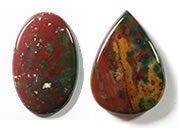 |
Bloodstone |
 |
Rock Tumblers |
 |
Diamond |
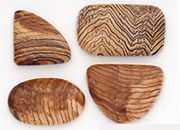 |
Opalized Wood |
 |
Tourmaline |
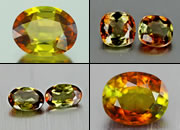 |
Andalusite |
 |
Blue Gemstones |
 |
100+ Gems |

Find Other Topics on Geology.com:

|

| ||

|

| ||

|

| ||

|

|

